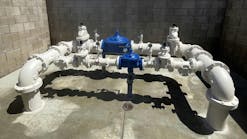By Don Schwerin
Let me save you some suspense and tell you right now: Yes! And you better pay attention!
After following these acts and definitions over the years, I felt I understood them until I had the pleasure of attending the WWEMA 44th Washington Forum held this past March in Washington, D.C. As a part of the program, I attended a presentation by Carolina Mederos, a principal with Squire Patton Boggs, on the subject of “Navigating Buy America(n) and American Iron and Steel” that helped me understand and appreciate the differences between them and the impact they have on our future industry and the American people.
Domestic procurement laws have been around for a long time and were originally intended to have the American government spend procurement money on American goods to support U.S. jobs, innovation, and manufacturing. The first federal domestic procurement law was the Buy American Act of 1933, which mandates that the U.S. federal government prefer U.S.-made products and construction materials for most purchases above a certain dollar threshold. The interpretation of this law was that the criteria for meeting Buy American was substantial transformation, which is a performance-based criteria. It does not tell you how to meet the process requirements; it only tells you the outcome of the process. The definition of substantial transformation is production that results in a new and different good, which is different from those of its constituent materials.
A similar provision in the Surface Transportation Assistance Act of 1982 was given an entirely different interpretation by the Federal Highway Administration (FHWA) and became known as Buy America. It applies to purchases related to road transportation and some types of mass transit projects, including construction of highways and transit stations. Instead of performance-based compliance by means of substantial transformation, compliance is process-based and is measured by adhering to the requirements that are described in how to achieve it.
The American Recovery and Reinvestment Act of 2009 (ARRA) was a stimulus package signed into law by President Barack Obama in 2009. This law incorporated both a Buy America and Buy American aspect depending upon the situation. If a product was 100 percent iron or steel, manufacturing considerations or origin of the ore did not matter as long as all refining, processing, stamping, and forming of the material was done in the U.S. (Note this requirement did not mention melting or coatings.) This follows the Buy America process-based criteria. Any “manufactured good” made with less than 100 percent iron or steel was considered compliant if it was “substantially transformed” in the U.S. regardless of the origins of the components — as long as substantial time, skill, and money were required in the transformation. This follows performance-based Buy American criteria.
The Consolidated Appropriations Act of 2014 included an American Iron and Steel (AIS) requirement. Clean Water State Revolving Fund (CWSRF) and Drinking Water State Revolving Fund (DWSRF) assistance recipients are required to use iron and steel products that are produced in the United States for projects for the construction, alteration, maintenance, or repair of a public water system or treatment works. This Act went back to Buy America in that the compliance criteria is process-based. All processes, starting with the melting of the raw materials through coatings, have to be done in the U.S. These requirements apply to a specified list of products, as further defined by EPA Guidance, but exempts complex products and systems such as pumps, motors, gear reducers, mixers, motorized screens (such as traveling screens), blowers/aeration equipment, compressors, membrane bioreactor systems, membrane filtration systems, filters, clarifiers and clarifier mechanisms, grinders, disinfection systems, presses (including belt presses), heat exchangers, and dewatering equipment. It also exempts any products with less than 50 percent iron or steel as measured by cost.
So why does it really matter? In 1982, all integrated steel mills melted their raw materials. Therefore, the Buy America requirement eliminated foreign competition and included the whole U.S. steel industry. The industry subsequently changed but regulations requiring Buy America did not. In 1982, there were 35 integrated mills; today there are 11 and those are owned by three steel companies. Today these 11 integrated mills produce only 31 percent of the steel produced in the U.S. The industry today is dominated instead by some mills that remelt steel scrap (and do meet Buy America) while others hot-roll steel slabs to 50-100 degrees short of melting and therefore do not meet the Buy America process-based criteria. The result is that we are looking at a potential shortage of steel that meets the current Buy America requirements.
Where is this going? President Trump is promoting Buy American/Hire American. What does that mean? A Presidential Memorandum aimed at the construction of American pipelines applies Buy America to private transactions (not just federally funded transactions). Senate Bill S. 181 defines “produced in the U.S.” as “all manufacturing processes, from the initial melting stage…” which is the Buy America definition and applies it to all DOD, GSSA, Army Corps of Engineers, Amtrak and FAA procurement (all of which were allowed to meet Buy American in the past). It also prohibits federal funds for any agency that does not meet Buy America.
H.R. Bill 904 extends Buy America to Dept. of Agriculture Rural Utilities Service programs, HUD Community Development Block Grants and HOME programs, Dept. of Interior, Bureau of Reclamation Rural Water Supply program, Dept. of Commerce, Economic Development Administration funds used in Clean Water SRF projects, and DOT/FRA RRIF loan programs — none of which had domestic preference standards before. House Bill H.R. 939 will make AIS and its Buy America definition a permanent part of the Drinking Water SRF program as currently exists for the Clean Water SRF, although the Interior Environmental Subcommittee is trying to redefine AIS as meaning Buy American instead of Buy America.
The bottom line is this: Buy America keeps out foreign iron and steel but eliminates many U.S. companies and workers and limits eligibility to only certain specific steel mills. Buy American also keeps out foreign iron and steel but qualifies all U.S. mills to provide the material. The former could result in a shortage of steel and greatly inflated costs, whereas the latter could result in a stimulus to U.S. businesses, workers and the American people. It’s time to get involved!
About the Author: Don Schwerin is sales support manager for Evoqua Water Technologies and a member of the Water and Wastewater Equipment Manufacturers Association (WWEMA) Board of Directors. For more information about WWEMA visit www.wwema.org.


